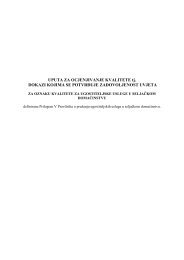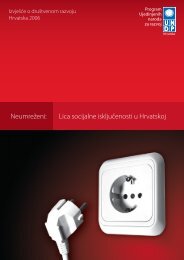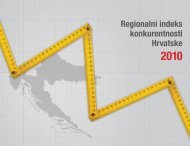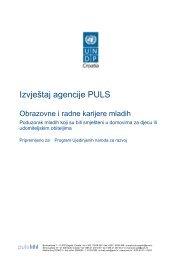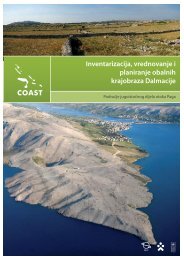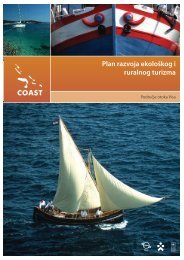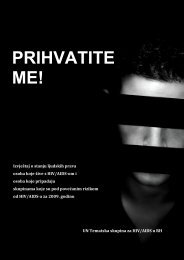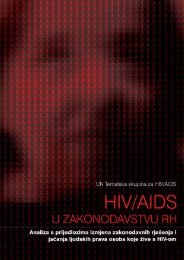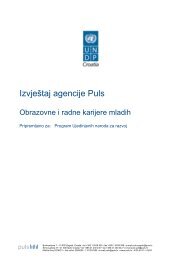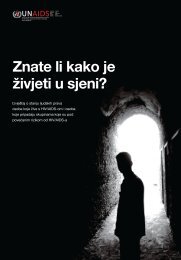WEB engleska verzija end.indd - UNDP Croatia
WEB engleska verzija end.indd - UNDP Croatia
WEB engleska verzija end.indd - UNDP Croatia
- No tags were found...
You also want an ePaper? Increase the reach of your titles
YUMPU automatically turns print PDFs into web optimized ePapers that Google loves.
THE SOCIALLY EXCLUDEDCHAPTER 33.9.7 Social TiesIn order to reduce the negative effects of incarceration,inmates need contact with the outside world,including access to information through the media,as well as through personal correspondence,telephone calls and visits. While serving sentences,inmates are entitled to visits from family memberstwice a month and on holidays, while under-agechildren can visit their parents every week and onholidays. Maintaining family ties and contacts withthe social environment is crucial to the future reintegrationof inmates back into society. However, theremote location of penitentiaries frequently presentsan obstacle to maintaining social ties, which affectsthe rights of both the inmate as well as their family.In closed penitentiaries, visits are supervised for securityreasons, however, the supervision needs to beorganised in such a way that respects the rights ofthe inmate’s privacy, but also prevents abuses thatmight jeopardise security.Conjugal visits are regarded as a privilege, howeverinmates frequently dispute the logic of treating suchvisits as privilege. Based on special approval, institutions,NGOs, the media and members of the localcommunity conducting research may visit penitentiariesas well. However, there are very few NGOs thatoffer programmes suitable for the prison population.There are several associations that take an active partin the treatment of substance abuse in penitentiariesand prisons, and this kind of cooperation also continuesafter the inmate leaves the facility. Interactiveworkshops which were organised for the wider prisonpopulation by the associations such as the “Art of Living”and the CAHIV (<strong>Croatia</strong>n Association for HIV) arean example of good cooperation between the prisonsystem and NGOs.3.9.8 Key ChallengesIn order to maintain incarceration as a “last resort”, legalalternatives to detention - available in the implementingphase of the criminal procedure - need to be morewidely adopted. Statistics show that a small number ofpeople in the prison population require maximum securitymeasures and the restriction of communicationin order to prevent their undesirable or dangerous activities.The penal system faces a challenge to developingand intensifying programmes which would enableinmates to behave responsibly and permit them toserve their sentences under more lenient conditions.An additional challenge is raising public awarenessabout the rehabilitation approach to inmates chargedwith criminal offences, which would lead to fewer difficultiesin their social integration, both while servingtheir sentences and after discharge.3.9.9 Policy ImplicationsIn order to achieve transparency and accountabilityin a closed prison system, an indep<strong>end</strong>ent bodyof citizens should be established that could visitpenitentiaries and prisons without any restrictions,communicate with inmates and report findings tothe public and the Parliament. Ensuring adequatefinancing for the prison system should, in additionto satisfying accommodation standards, include theacquisition of technical security devices (walls, videosurveillance) which would decrease the need for firearmswithin the prison. The establishment of a probationsystem would open up the possibility of shorterterms of incarceration, as well as create conditions fora larger number of alternative sanctions, thus raisingthe level of humanity and protection of human rightsin the implementation of criminal sanctions.93



